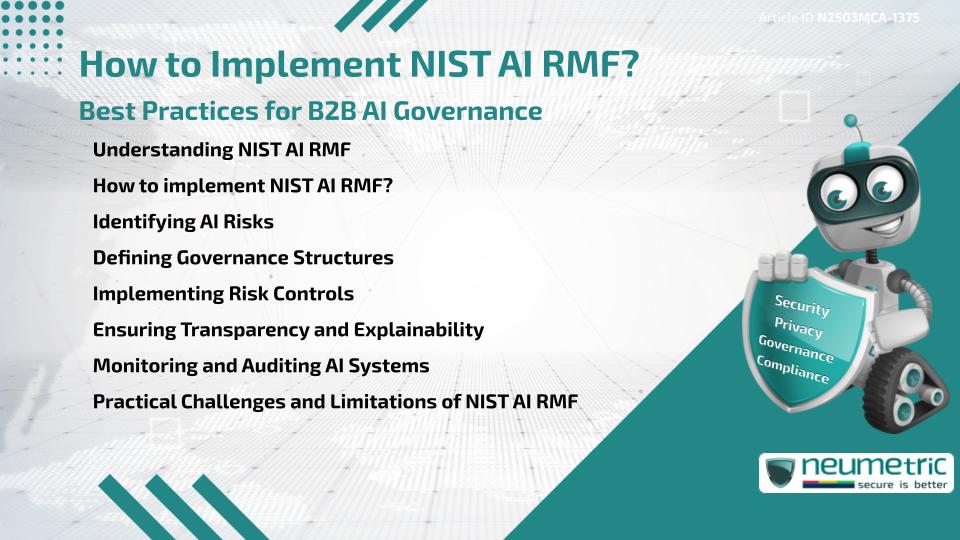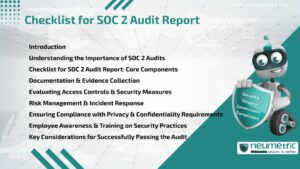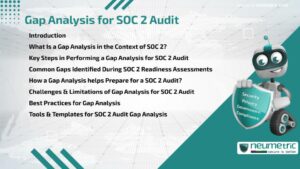Artificial intelligence [AI] is transforming businesses worldwide, but with its rapid growth comes the responsibility to manage its risks effectively. To help organisations navigate this, the National Institute of Standards and Technology [NIST] introduced the AI Risk Management Framework [AI RMF]. This framework provides guidance on managing AI Risks across its lifecycle, from Design to Deployment. But, How to implement NIST AI RMF? In this article, we will explore best practices for implementing NIST AI RMF in B2B environments, focusing on Governance, Compliance, and real-world applications.
Table of Contents
ToggleUnderstanding NIST AI RMF
NIST AI RMF provides a structured approach for Identifying, Assessing, and Managing the Risks associated with AI technologies. It is designed to support AI Development by ensuring that it is both trustworthy and aligned with Ethical and Regulatory requirements. The framework is built around core principles such as Fairness, Transparency, Accountability, and Robustness.
When implementing NIST AI RMF, it is essential to understand these guiding principles and apply them in real-world scenarios. This includes evaluating potential biases in Data, ensuring AI models are explainable, and establishing Accountability measures throughout the AI lifecycle.
How to implement NIST AI RMF?
1. Identifying AI Risks
The first step in implementing NIST AI RMF is identifying the risks inherent in AI systems. These could be technical, such as Security vulnerabilities, or ethical, like biases in Data that could lead to unfair outcomes. A thorough Risk Assessment should involve all stakeholders, including data scientists, business leaders, and legal experts, to understand the full scope of potential risks.
2. Defining Governance Structures
Effective AI Governance requires clear structures to manage risks and ensure Compliance. This includes setting up roles and responsibilities for AI risk management, defining policies for Data handling, and establishing Audit trails. Businesses should create Governance teams that are responsible for overseeing the implementation of AI RMF, ensuring Compliance with both internal standards and external regulations.
3. Implementing Risk Controls
Once Risks are identified, it is crucial to implement the appropriate controls to mitigate them. This can involve the use of AI monitoring systems, Data Quality Assurance practices, and Model Validation techniques. For example, if a risk is associated with biased Data, steps should be taken to clean and preprocess the data before it is fed into an AI system. Additionally, businesses should continuously monitor AI systems to detect any issues early and take corrective actions.
4. Ensuring Transparency and Explainability
A critical component of NIST AI RMF is ensuring that AI systems are transparent and explainable. This means that businesses must have processes in place to document how AI models make decisions. For instance, using explainable AI tools can help businesses track the reasoning behind AI predictions, which is especially important for Regulatory Compliance. Transparency also builds trust with users and stakeholders, showing that AI decisions are made fairly and ethically.
5. Monitoring and Auditing AI Systems
AI systems are dynamic, so it is important to continuously monitor their performance and Compliance. Regular Audits help ensure that AI systems are functioning as expected and that they do not deviate from ethical standards or regulatory requirements. Businesses should establish periodic reviews to evaluate the accuracy of AI models and adjust them as necessary to address any emerging risks.
Practical Challenges and Limitations of NIST AI RMF
While implementing NIST AI RMF offers significant benefits, there are some practical challenges and limitations to consider. One of the primary challenges is the complexity of AI systems. Their dynamic and self-learning nature means that Risk Management is an ongoing process rather than a one-time task. As AI models evolve, businesses must adapt their Governance strategies to ensure they remain compliant with the framework.
Another challenge is the shortage of skilled professionals who are knowledgeable about both AI Technologies and Risk Management frameworks. For many organisations, Training or Hiring staff with the expertise needed to implement NIST AI RMF can be costly and time-consuming.
Additionally, some businesses may struggle to integrate the NIST AI RMF with existing Governance and Compliance frameworks. Aligning multiple systems and processes can require significant adjustments in workflows and communication, which may be met with resistance from internal teams.
Analogies to Simplify NIST AI RMF Implementation
Think of implementing NIST AI RMF like setting up a safety system for a car. Just as a car needs functioning brakes, seatbelts, and airbags to ensure safety, an AI system requires proper Governance, transparency, and monitoring to ensure it operates safely and fairly. While these components are crucial for the car’s performance, they also need to be maintained regularly. Similarly, AI Governance must be continuously updated and monitored to keep the system in line with evolving risks and regulatory requirements.
Conclusion
Implementing NIST AI RMF is a critical step in ensuring that AI technologies are developed and deployed responsibly, especially in B2B environments. By focusing on Risk Identification, Governance, Transparency, and Continuous Monitoring, businesses can not only improve the safety and fairness of their AI systems but also build trust with customers and regulators.
Takeaways
- NIST AI RMF provides a comprehensive framework for managing AI risks.
- Governance structures, Risk Identification, and Transparency are key to successful implementation.
- Continuous monitoring and auditing are necessary to ensure ongoing compliance.
- Businesses must address challenges like AI system complexity and staff expertise when implementing the framework.
FAQ
What are the main principles of NIST AI RMF?
The key principles of NIST AI RMF include Fairness, Transparency, Accountability, and Robustness. These principles guide businesses in managing AI risks effectively.
How can businesses monitor AI systems for Compliance with NIST AI RMF?
Businesses can monitor AI systems by conducting Regular Audits, using AI Monitoring tools, and ensuring ongoing evaluation of AI model performance to detect and correct any issues early.
What challenges might businesses face when implementing NIST AI RMF?
Challenges include the complexity of AI systems, a shortage of skilled professionals, and the difficulty of integrating AI Risk Management into existing Governance frameworks.
Why is transparency important in AI Governance?
Transparency ensures that AI systems are explainable and that stakeholders understand how decisions are made. This helps to build trust and comply with regulatory requirements.
How can businesses identify risks in AI systems?
Businesses should conduct a comprehensive Risk Assessment involving stakeholders from various departments to identify both technical and ethical risks in AI systems.
Is NIST AI RMF applicable to all types of AI systems?
Yes, NIST AI RMF is designed to be flexible and can be applied to various AI systems, including Machine Learning, Deep Learning, and Natural Language Processing models.
Can small businesses implement NIST AI RMF?
Yes, although small businesses may face resource constraints, they can still implement NIST AI RMF by starting with basic Risk Assessments and Governance practices and gradually expanding them.
How does NIST AI RMF contribute to AI ethics?
NIST AI RMF helps businesses ensure that AI systems are ethical by addressing biases, promoting transparency, and ensuring that AI decisions are accountable.





